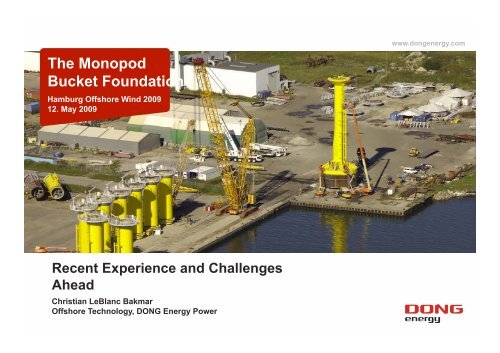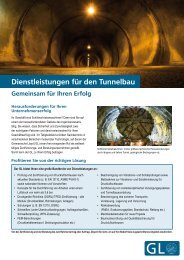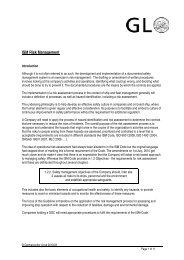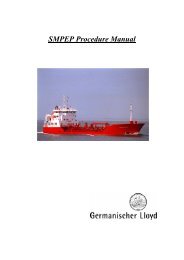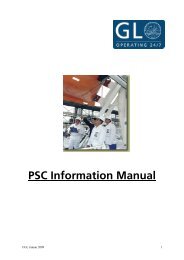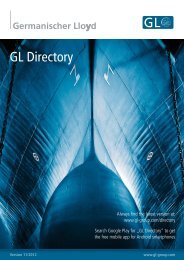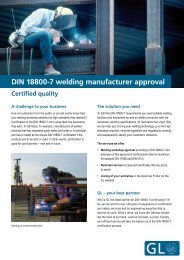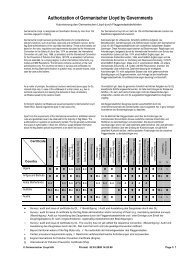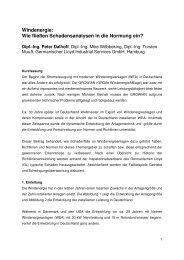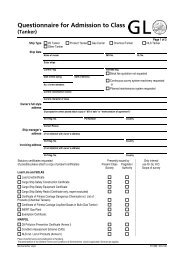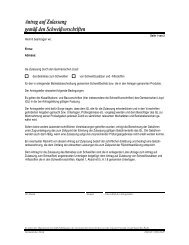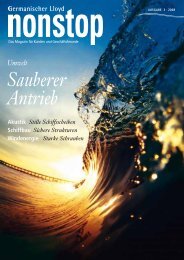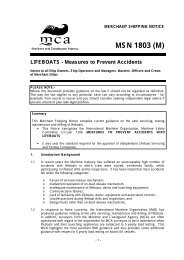The Monopod Bucket Foundation - GL Group
The Monopod Bucket Foundation - GL Group
The Monopod Bucket Foundation - GL Group
You also want an ePaper? Increase the reach of your titles
YUMPU automatically turns print PDFs into web optimized ePapers that Google loves.
<strong>The</strong> <strong>Monopod</strong><br />
<strong>Bucket</strong> <strong>Foundation</strong><br />
Hamburg Offshore Wind 2009<br />
12. May 2009<br />
Recent Experience and Challenges<br />
Ahead<br />
Christian LeBlanc Bakmar<br />
Offshore Technology, DONG Energy Power<br />
www.dongenergy.com
GENERATION - CHRLE<br />
Agenda<br />
�� 1. Introduction<br />
Background and history of the monopod bucket<br />
foundation concept.<br />
�� 2. Motivation<br />
Why is there an interest in commercialising the monopod<br />
bucket foundation?<br />
�� 3. Recent experience<br />
Successful installation of <strong>The</strong> Mobile Met Mast at Horns<br />
Rev 2 Offshore Wind Farm.<br />
�� 4. Challenges ahead<br />
What are the main challenges for commercialisation of the<br />
monopod suction caisson.<br />
�� 5. Concluding remarks<br />
2
GENERATION - CHRLE<br />
Introduction<br />
<strong>The</strong> <strong>Monopod</strong> <strong>Bucket</strong> <strong>Foundation</strong>:<br />
�� A hybrid of a monopile and a<br />
gravity based foundation.<br />
�� Cost efficiency is improved if<br />
the ratio diameter/skirt length is<br />
approximately 1.<br />
3
GENERATION - CHRLE<br />
<strong>The</strong> installation technology<br />
Downward pressure on<br />
lid, due to suction<br />
Reduction of tip resistance, due to<br />
flow induced in soil<br />
4<br />
Skirt tip injection for<br />
vertical alignment and reduced<br />
tip resistance
GENERATION - CHRLE<br />
Previous research & development, since 2001<br />
Development has been undertaken MBD Offshore Power A/S.<br />
Test field in Frederikshavn:<br />
�� Medium-scale testing in sand<br />
(2x2 m and 4x4 m)<br />
Aalborg University:<br />
�� Laboratory testing in sand<br />
�� Numerical modelling<br />
Tests performed:<br />
�� Installation tests<br />
�� Monotonic moment loading tests<br />
�� Cyclic moment loading tests<br />
Methods and techniques derived for:<br />
�� Installation using suction<br />
�� Vertical installation using skirt tip injection<br />
�� Static and cyclic moment resistance<br />
5
GENERATION - CHRLE<br />
Previous prototypes<br />
Frederikshavn, Denmark<br />
2003<br />
�� Designed for 3 MW Vestas turbine<br />
�� Successfull installation<br />
�� Post-installation monitoring program was conducted<br />
Skirt dimensions: D = 12 m, L = 6 m<br />
Wilhelmshaven, Germany<br />
2005<br />
�� Designed for a 5-MW Enercon turbine<br />
�� <strong>The</strong> installation failed. <strong>The</strong> installation barge<br />
floated sideways and colided with the bucket<br />
during the installation process. <strong>The</strong> impact with<br />
the bucket skirt initiated buckling after only 7 m<br />
penetration.<br />
Skirt dimensions: D = 16 m, L = 15 m<br />
6
GENERATION - CHRLE<br />
MBD Offshore Power A/S<br />
October 2006<br />
MBD Offshore Power A/S became a subsidy of DONG Energy.<br />
<strong>The</strong> group holds patents encompassing the installation<br />
technology.<br />
DONG Energy is promoting the further development of the<br />
monopod bucket foundation through MBD Offshore Power A/S.<br />
7
GENERATION - CHRLE<br />
Agenda<br />
�� 1. Introduction<br />
Background and history of the monopod bucket<br />
foundation concept.<br />
�� 2. Motivation<br />
Why is there an interest in commercialising the monopod<br />
bucket foundation?<br />
�� 3. Recent experience<br />
Successful installation of <strong>The</strong> Mobile Met Mast at Horns<br />
Rev 2 Offshore Wind Farm.<br />
�� 4. Challenges ahead<br />
What are the main challenges for commercialisation of the<br />
monopod suction caisson.<br />
�� 5. Concluding remarks<br />
8
GENERATION - CHRLE<br />
Motivation<br />
Commercialization of the monopod bucket foundation:<br />
��We estimate that the bucket foundation can be more costeffective<br />
than the monopile.<br />
��<strong>The</strong> monopod bucket foundation is a feasible foundation<br />
concept for several sites in DONG Energy's current offshore<br />
portfolio.<br />
��<strong>The</strong> concept is environmentally friendly<br />
(silent and reversible installation).<br />
��Patented technology - possible commercialization of IPR and<br />
use in other projects.<br />
9
GENERATION - CHRLE<br />
Some pros and cons<br />
Pros<br />
�� Less steel is required compared to the monopile<br />
�� Installable without the use of heavy cranes<br />
�� No transition piece is required<br />
�� No hammer is required<br />
�� Stiffer structure than the monopile, resulting in less dynamic<br />
amplification of loads. Important for deeper waters<br />
�� <strong>The</strong> need for scour protection can be eliminated<br />
�� <strong>The</strong> installation process can be reversed<br />
�� Silent installation process - no pile driving is required<br />
�� Floatable foundation - limited storage area needed during fabrication<br />
Cons<br />
�� More complicated structure to fabricate<br />
�� Require grouting beneath the bucket lid<br />
�� Can only be used in certain types of soil<br />
�� Float-out to site requires sufficient water depth in the harbor<br />
�� More “high-tech” than the monopile – more can go wrong<br />
�� More vulnerable concept<br />
10
GENERATION - CHRLE<br />
DONG Energy's Offshore Portfolio<br />
In operation<br />
Under construction<br />
Use of monopod bucket foundations:<br />
Non-applicable<br />
Partly or maybe applicable<br />
Applicable<br />
Walney II<br />
Walney I<br />
West of Duddon Sands<br />
Scarweather Sands<br />
Wigtown Bay<br />
Burbo<br />
Barrow<br />
Shell Flat<br />
Gunfleet Sands<br />
Westermost Rough<br />
London Array II<br />
London Array I<br />
11<br />
Frederikshavn Offshore<br />
Horns Rev II<br />
Horns Rev I<br />
Borkum Riffgrund II<br />
Borkum Riffgrund I<br />
Tunø Knob<br />
Vindeby<br />
Nysted<br />
Middelgrunden
GENERATION - CHRLE<br />
Agenda<br />
�� 1. Introduction<br />
Background and history of the monopod bucket<br />
foundation concept.<br />
�� 2. Motivation<br />
Why is there an interest in commercialising the monopod<br />
bucket foundation?<br />
�� 3. Recent experience<br />
Successful installation of <strong>The</strong> Mobile Met Mast at Horns<br />
Rev 2 Offshore Wind Farm.<br />
�� 4. Challenges ahead<br />
What are the main challenges for commercialisation of the<br />
monopod suction caisson.<br />
�� 5. Concluding remarks<br />
12
GENERATION - CHRLE<br />
<strong>The</strong> Mobile Met Mast<br />
"<strong>The</strong> Mobile Met Mast" is a prototype of<br />
a monopod bucket foundation designed<br />
as a support structure for a met-mast.<br />
Purpose:<br />
�� To gain confidence that a monopod<br />
bucket foundation can be successfully<br />
installed offshore.<br />
�� To obtain a movable met-mast,<br />
which can be used in several offshore<br />
wind farms.<br />
Specs<br />
��Total height: 38 m<br />
��Weight: 165 tons<br />
��Skirt length: 6 m<br />
��Skirt diameter: 12 m<br />
Fabricated in Aalborg in August 2008.<br />
Installed at Horns Rev 2 Offshore wind<br />
farm in March 2009.<br />
13
GENERATION - CHRLE<br />
Fabrication<br />
�� Fabricated by Bladt Industries A/S,<br />
Denmark<br />
�� Steel structure<br />
�� Plate girder lid<br />
�� Cold rolled and welded skirt<br />
14
GENERATION - CHRLE<br />
Fabrication<br />
�� <strong>The</strong> geometric skirt imperfertions was measured by a 3D<br />
point cloud laser scanner<br />
�� <strong>The</strong> maximum out-of-roundness was ± 50mm<br />
�� <strong>The</strong> largest imperfections were along the vertical weldings<br />
15
GENERATION - CHRLE<br />
Pumping Equipment<br />
Pumping equipment was installed for:<br />
�� Adding suction in the bucket<br />
�� Skirt tip injection<br />
�� Adding or emptying water from parts of the<br />
foundation body<br />
�� Adding air into the bucket skirt<br />
16
GENERATION - CHRLE<br />
Launching<br />
17
GENERATION - CHRLE<br />
Site for installation<br />
Horns Rev 2<br />
Wind turbines:<br />
��91 Siemens 2.3MW<br />
��200 MW<br />
Scheduled installation:<br />
��- 2008: <strong>Foundation</strong>s<br />
��- 2009: Turbines<br />
<strong>The</strong> Mobile Met Mast<br />
��3 installation tests were<br />
planned at different<br />
locations<br />
(depending on weather)<br />
��Was only installed at the<br />
final location<br />
��No data from CPT or<br />
borings are available (yet)<br />
Horns Rev 1<br />
18<br />
Esbjerg<br />
Denmark
GENERATION - CHRLE<br />
Float out to site<br />
�� Floated to site using 2 tug boats<br />
�� 40 m 3 water was pumped into the<br />
head of the Mobile Met-Mast in order<br />
to ensure a horizontal orientation<br />
when floating<br />
19
GENERATION - CHRLE<br />
Up-ending procedure<br />
�� Up-ended with M/S SeaPower by A2SEA<br />
�� <strong>The</strong> lift was performed with a heave-compensator<br />
�� Water depth (15 m) was close to the lower limit – only 1 meter of<br />
water below skirt during up-ending.<br />
�� Inflation/deflation of air in the bucket skirt was necessary during<br />
up-ending<br />
20
GENERATION - HCASA<br />
21
GENERATION - CHRLE<br />
Up-ending procedure<br />
22
GENERATION - CHRLE<br />
Up-ending procedure<br />
23
GENERATION - CHRLE<br />
Adding connections<br />
24
GENERATION - CHRLE<br />
Installation<br />
�� A penetration velocity of 2 m/<br />
hour was obtained<br />
�� After 2.5 m penetration, the<br />
foundation started tilting. At 4 m<br />
penetration, the process was<br />
reversed until 3 m penetration.<br />
<strong>The</strong>n the penetration process<br />
was repeated without tilting<br />
problems. We believe the tilt<br />
problem was caused by a stone<br />
along the skirt circumference.<br />
�� <strong>The</strong> flow induced in the soil was<br />
blocked, indicating that a clay<br />
layer was present. Installation<br />
continued.<br />
�� <strong>The</strong> foundation was successfully<br />
installed with a 0.1 degree<br />
inclination out of vertical.<br />
25
GENERATION - CHRLE<br />
Scour development<br />
�� Scour is critical during and<br />
after installation.<br />
�� During up-ending and<br />
installation there were<br />
currents of ± 1 knot.<br />
�� Local scour holes,<br />
approximately 1m deep,<br />
had developed on two sides<br />
of the bucket.<br />
�� No scour protection has<br />
been installed.<br />
�� Monitoring of the scour<br />
development continues.<br />
26
GENERATION - CHRLE<br />
Installation time<br />
�� Time from jacking-up to complete installation was 32 hours.<br />
�� In comparison, the first monopile was installed at Horns Rev II in 31<br />
hours and at Horns Rev I in over 2.5 days.<br />
�� Mounting and unmounting of connections was very time consuming.<br />
�� Room for much optimization - it is estimated that the operation could<br />
be performed in less than 10 hours.<br />
Other<br />
5.5 h<br />
Jack-up and<br />
preload<br />
1.5 h<br />
Time distribution<br />
Mounting<br />
connections<br />
11.5 h<br />
Installation<br />
10 h<br />
Preparation of<br />
lifting equip.<br />
2 h<br />
Up-ending<br />
foundation; 1.5<br />
h<br />
27
GENERATION - CHRLE<br />
Agenda<br />
�� 1. Introduction<br />
Background and history of the monopod bucket<br />
foundation concept.<br />
�� 2. Motivation<br />
Why is there an interest in commercialising the monopod<br />
bucket foundation?<br />
�� 3. Recent experience<br />
Successful installation of <strong>The</strong> Mobile Met Mast at Horns<br />
Rev 2 Offshore Wind Farm.<br />
�� 4. Challenges ahead<br />
What are the main challenges for commercialisation of the<br />
monopod suction caisson.<br />
�� 5. Concluding remarks<br />
28
GENERATION - CHRLE<br />
Further research & development<br />
Motivation for further research & development:<br />
<strong>Foundation</strong>s are a vital part of an offshore wind farm –<br />
foundation failure is crucial!<br />
Statistically, 1 of 3 prototypes have failed so far. This clearly<br />
underlines the vulnerability of the concept.<br />
<strong>The</strong> monopod bucket foundation will not be commercialized<br />
before we are completely confident that we are able to handle<br />
all risks successfully!<br />
We are not there yet!<br />
Further research, development and prototype testing are<br />
necessary in order to:<br />
a)� eliminate all major risks associated with the foundation<br />
concept<br />
b)� increase the cost-efficiency of the foundation concept<br />
29
GENERATION - CHRLE<br />
Managing risks<br />
Installation failure; complete penetration cannot be obtained<br />
Accurate prediction of the installation process is important in order to<br />
ensure a successful installation. Our experience is mainly in installation of<br />
monopod bucket foundations in sand.<br />
Further work is undertaken to gain knowledge with:<br />
�� Installation in layered soils<br />
�� Installation in clays and silts<br />
�� <strong>The</strong> effects of skirt imperfections on penetration resistance<br />
Structural failure; collapse of the bucket during installation<br />
<strong>Monopod</strong> bucket foundations fall into the category of thin shell structures<br />
and are therefore particularly exposed to structural buckling.<br />
Further work is undertaken in order to:<br />
�� obtain accurate prediction of buckling limits<br />
�� investigate ways in increasing the robustness of future buckets in a costeffective<br />
manner, e.g. by addition of stiffeners<br />
30
GENERATION - CHRLE<br />
Managing risks<br />
Unforeseen ground conditions; risk of installation failure due to e.g.<br />
boulders in the soil.<br />
<strong>The</strong> geotechnical site investigations may be extended in order to<br />
minimize the risk of unforeseen ground conditions.<br />
For example, acoustic intensity imaging may be used to determine<br />
sub-seabed stratigraphy and identify buried geohazards, such as<br />
boulders, e.g. the Acustic Corer by PanGeo Subsea, which is a<br />
seabed deployed unit with subsurface scanning sonar heads<br />
attached to a boom rotating to cover 360 degrees.<br />
31<br />
Acustic Corer by PanGeo Subsea
GENERATION - CHRLE<br />
Concept development<br />
Design and fabrication<br />
<strong>The</strong> bucket lid:<br />
�� Plate girder lid<br />
�� Conical transition<br />
�� Concrete lid + dry dock construction<br />
<strong>The</strong> bucket skirt:<br />
�� methods to reduce geometrical imperfections<br />
�� use of stiffeners?<br />
�� other?<br />
Installation methodology<br />
<strong>The</strong>re are several possibilities for installing a<br />
monopod bucket foundation:<br />
�� Horizontal floating transport + up-ending using a<br />
crane or an external pile gripper on a jack-up/vessel<br />
or by buoyancy alone.<br />
�� Vertical transport on barge or jack-up + lift with<br />
crane on jack-up<br />
�� Vertical floating transport in arrays + lift by vessel<br />
�� Other?<br />
32<br />
Monopile and transition pieces on a barge,<br />
Horns Rev 2 Offshore Wind Farm
GENERATION - CHRLE<br />
Technical development<br />
Coupling device<br />
Adding connections, hoses etc., is very time-consuming.<br />
A module for rapid coupling needs to be developed. <strong>The</strong> module<br />
will attach to the bucket lid and contain pumping equipment,<br />
sensors, hoses etc.<br />
Lid excavation<br />
<strong>The</strong> installed capacity of the bucket foundation may be<br />
significantly increased, if it is possible to excavate soil beneath the<br />
lid and penetrate the bucket further into the ground. This may<br />
also eliminate the need for scour protection.<br />
33
GENERATION - CHRLE<br />
Future prototypes<br />
Onshore test bucket, diameter 8m<br />
<strong>The</strong> primary purpose is to develop and test a lid<br />
excavation system and coupling device.<br />
Installation site: Onshore test facility in Frederikshavn<br />
Commencement date: fall 2009<br />
Full-scale prototype<br />
Offshore installation of a full-scale prototype, probably<br />
for a 3.6 MW wind turbine.<br />
Installation site: To be decided<br />
A location at Borkum Riffgrund is a possibility.<br />
Expected installation date:<br />
Late 2010 / Early 2011<br />
34
GENERATION - CHRLE<br />
Agenda<br />
�� 1. Introduction<br />
Background and history of the monopod bucket<br />
foundation concept.<br />
�� 2. Motivation<br />
Why is there an interest in commercialising the monopod<br />
bucket foundation?<br />
�� 3. Recent experience<br />
Successful installation of <strong>The</strong> Mobile Met Mast at Horns<br />
Rev 2 Offshore Wind Farm.<br />
�� 4. Challenges ahead<br />
What are the main challenges for commercialisation of the<br />
monopod suction caisson.<br />
�� 5. Concluding remarks<br />
35
GENERATION - CHRLE<br />
Technology jump?<br />
36
GENERATION - CHRLE<br />
Thank you for listening<br />
37


